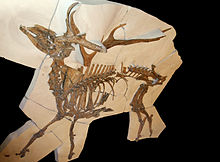| Cervus elaphus acoronatus | |
|---|---|

| |
| Skeleton in anatomical connection of Cervus elaphus acoronatus discovered in Sovere, Bergamo | |
| Scientific classification | |
| Domain: | Eukaryota |
| Kingdom: | Animalia |
| Phylum: | Chordata |
| Class: | Mammalia |
| Order: | Artiodactyla |
| Family: | Cervidae |
| Genus: | Cervus |
| Species: | C. elaphus |
| Subspecies: | †C. e. acoronatus |
| Trinomial name | |
| †Cervus elaphus acoronatus (Beninde, 1937) | |
Cervus elaphus acoronatus is an extinct subspecies of the red deer belonging to the family Cervidae. Some authors consider it a distinct species, Cervus acoronatus.
Description


Cervus elaphus acoronatus was a red deer subspecies of large size, similar to that of the existing red deer, Cervus elaphus, with large and well-developed antlers. In this archaic form, the antlers lack at their apices, even in adult individuals, the characteristic multipointed "crown" (hence the Latin name acoronatus, meaning without crown). In this subspecies, the antlers have a simple distal fork oriented transversally to the axis of the body.
It is a deer of Eastern origin, reported in Central Europe in the Pleistocene. The fossil records of C. e. acoronatus start in the lower Middle Pleistocene. Later, the morphology of the antlers changed, developing the mentioned crown.
References
- Global Names Indexer
- Laura Abbazzi, A. Azzaroli - Occurrence of palmated Cervus elaphus from Italian late Pleistocene localities
Further reading
- Anna Paganoni, Benedetto Sala - Il cervo di Sovere
- Taxonomy and biostratigraphy of Middle Pleistocene deer remains from Arago
| Taxon identifiers | |
|---|---|
| Cervus elaphus acoronatus | |